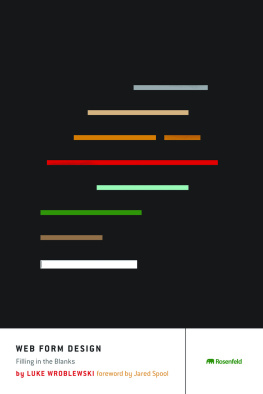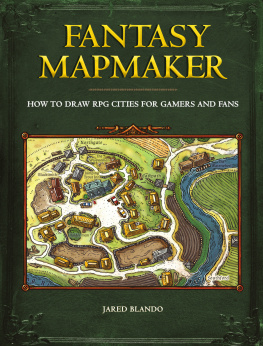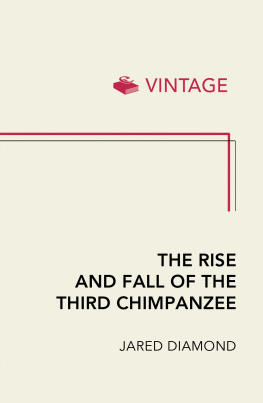Spool Jared - Web Form Design: Filling in the Blanks
Here you can read online Spool Jared - Web Form Design: Filling in the Blanks full text of the book (entire story) in english for free. Download pdf and epub, get meaning, cover and reviews about this ebook. City: New York, year: 2008, publisher: Rosenfeld Media, genre: Home and family. Description of the work, (preface) as well as reviews are available. Best literature library LitArk.com created for fans of good reading and offers a wide selection of genres:
Romance novel
Science fiction
Adventure
Detective
Science
History
Home and family
Prose
Art
Politics
Computer
Non-fiction
Religion
Business
Children
Humor
Choose a favorite category and find really read worthwhile books. Enjoy immersion in the world of imagination, feel the emotions of the characters or learn something new for yourself, make an fascinating discovery.
- Book:Web Form Design: Filling in the Blanks
- Author:
- Publisher:Rosenfeld Media
- Genre:
- Year:2008
- City:New York
- Rating:3 / 5
- Favourites:Add to favourites
- Your mark:
- 60
- 1
- 2
- 3
- 4
- 5
Web Form Design: Filling in the Blanks: summary, description and annotation
We offer to read an annotation, description, summary or preface (depends on what the author of the book "Web Form Design: Filling in the Blanks" wrote himself). If you haven't found the necessary information about the book — write in the comments, we will try to find it.
Web Form Design: Filling in the Blanks — read online for free the complete book (whole text) full work
Below is the text of the book, divided by pages. System saving the place of the last page read, allows you to conveniently read the book "Web Form Design: Filling in the Blanks" online for free, without having to search again every time where you left off. Put a bookmark, and you can go to the page where you finished reading at any time.
Font size:
Interval:
Bookmark:

By Luke Wroblewski
Rosenfeld Media, LLC
705 Carroll Street, #2L
Brooklyn, New York
11215 USA
On the web: www.rosenfeldmedia.com
Please send errors to:
Publisher: Louis Rosenfeld
Editor/Production Editor: Marta Justak
Interior Layout: Susan Honeywell
Cover Design: The Heads of State
Indexer: Nancy Guenther
Proofreader: Chuck Hutchinson
2008 Rosenfeld Media, LLC
All Rights Reserved
ISBN: 1-933820-24-1
ISBN-13: 978-1-933820-24-8
Library of Congress Control Number: 2008923241
Printed and bound in the United States of America
For everyone who has had to fill in a form.
W eb form design. Do we really need an entire book on such a mundane topic?
You bet we do. As arbiters of checkout, registration, and data entry, Web forms are often the lynchpins of successful Web applications.
- Checkout forms are how ecommerce vendors close dealsthey stand between people and the products or services they want and between companies and their profits. For example, eBays vast inventory (its the 30th largest economy in the world) is driven in no small part by its Sell Your Item form.
- Registration forms are the gatekeepers to community membershipthey allow people to define their identity within social applications. All of MySpaces 150+ million users joined through a Web form.
- Data input forms allow users to contribute or share information, and they allow companies to grow their content. Most of YouTubes huge video collection comes from its Upload Your Video form.
Web forms are often the last and most important mile in a long journey. Despite their importance, the design of forms is often poorly thought out and conceived. Your organization may have already invested heavily in opening a relationship with its customers through high-quality marketing, site design, and search engine optimization. But now it is time to close the deal by making sure those customers can complete your forms. And thats where this book will help.
Web Form Design: Filling in the Blanks is truly for anyone who needs to design or develop Web formsand who doesnt? Whatever type of designer you areusability engineer, Web developer, product manager, visual designer, interaction designer, or information architectyoure probably involved in Web form design in some fashion. This book will provide you with something that you can use immediately to improve your sites forms.
If youre a beginner, youll receive a broad overview of all the considerations that constitute good form design. If youre an experienced practitioner, youll engage at a deeper level with issues and solutions you may not have encountered before.
This book is a collection of the insights and best practices for Web form design Ive accumulated through 12 years of designing Web experiences. Wherever possible, Ive conducted or referenced research to better understand the impact of Web form design decisions. Where no research was available, Ive called on my own experiences and those of other designers and developers.
Just about every chapter in this book wraps up with a set of best practices that outline ways you can begin to apply the key points made within each chapter. Although these best practices can guide you toward the right design solutions for your forms, the content within each chapter explains the what, when, and why that informs each best practice.
Section One, Form Structure, begins with an overview of why form design matters and the principles behind good form design. The remaining chapters provide a set of best practices for organizing forms and focusing people on their primary goal of completing a form.
Section Two, Form Elements, dives into a series of best practices for the core components that make up forms: labels, input fields, actions, and messaging (help, errors, success). Here you will find information on aligning labels, required input fields, primary versus secondary actions, automatic help systems, and much more.
Section Three, Form Interaction, focuses on the process of filling in forms. From inline validation solutions that confirm or suggest valid answers to gradual engagement solutions that immerse people within a Web experience without forms, this section is about applying dynamic behavior to make forms more useful, usable, and enjoyable.
This books companion Web site (  www.rosenfeldmedia.com/books/webforms) contains pointers to useful Web form design articles that Ive found and Ive also written. It includes a calendar of my upcoming talks, and a place for you to engage in discussion with others interested in Web form design. We expect to post information on new Web form design-related resources and special discounts for related applications. You can keep up with the site by subscribing to its RSS feed (
www.rosenfeldmedia.com/books/webforms) contains pointers to useful Web form design articles that Ive found and Ive also written. It includes a calendar of my upcoming talks, and a place for you to engage in discussion with others interested in Web form design. We expect to post information on new Web form design-related resources and special discounts for related applications. You can keep up with the site by subscribing to its RSS feed (  http://feeds.rosenfeldmedia.com/webforms/)
http://feeds.rosenfeldmedia.com/webforms/)
Weve also made the books diagrams, screenshots, and other illustrations available under a Creative Commons license for you to download and use in your own presentations. Youll find them in Flickr (http://www.flickr.com/photos/rosenfeldmedia).
Forms enable commerce, communities, and productivity on the Web to thrive. If you are in online retail, your goal is to sell things. But standing in the way of your products and your customers is a checkout form. If you are developing social software, your goal is to grow your community. Standing in between you and community members is a form. If youve built a productivity-based Web application, forms enable key interactions that let people create and manage content. See for more information.
Who is filling the form in and why? Answering this up front allows us to think about our forms as a deliberate conversation instead of the inputs for a database. When you approach forms as a conversation, natural breaks will emerge between topics. When these distinct topics are short enough to fit into a few sections, a single Web page will probably work best to organize them. When each section begins to run long, multiple Web pages may be required to break up the conversation into meaningful, understandable topics. See .
When the questions that need to be answered before a Web form is complete are spread across multiple Web pages, you may want to include an overview of the number of Web pages involved (scope), an indication of what page you are on (position), and a way to save and return to your progress (status). Though closely integrated, these three progress indicators perform different functions. See .
When you are trying to reduce completion times or if you need flexible label lengths for localization, consider top-aligned labels. When you have similar goals but vertical screen real estate constraints, consider right-aligned labels. When your form requires people to scan labels to learn whats required or to answer a few specific questions out of many, consider left-aligned labels. See .
Font size:
Interval:
Bookmark:
Similar books «Web Form Design: Filling in the Blanks»
Look at similar books to Web Form Design: Filling in the Blanks. We have selected literature similar in name and meaning in the hope of providing readers with more options to find new, interesting, not yet read works.
Discussion, reviews of the book Web Form Design: Filling in the Blanks and just readers' own opinions. Leave your comments, write what you think about the work, its meaning or the main characters. Specify what exactly you liked and what you didn't like, and why you think so.












